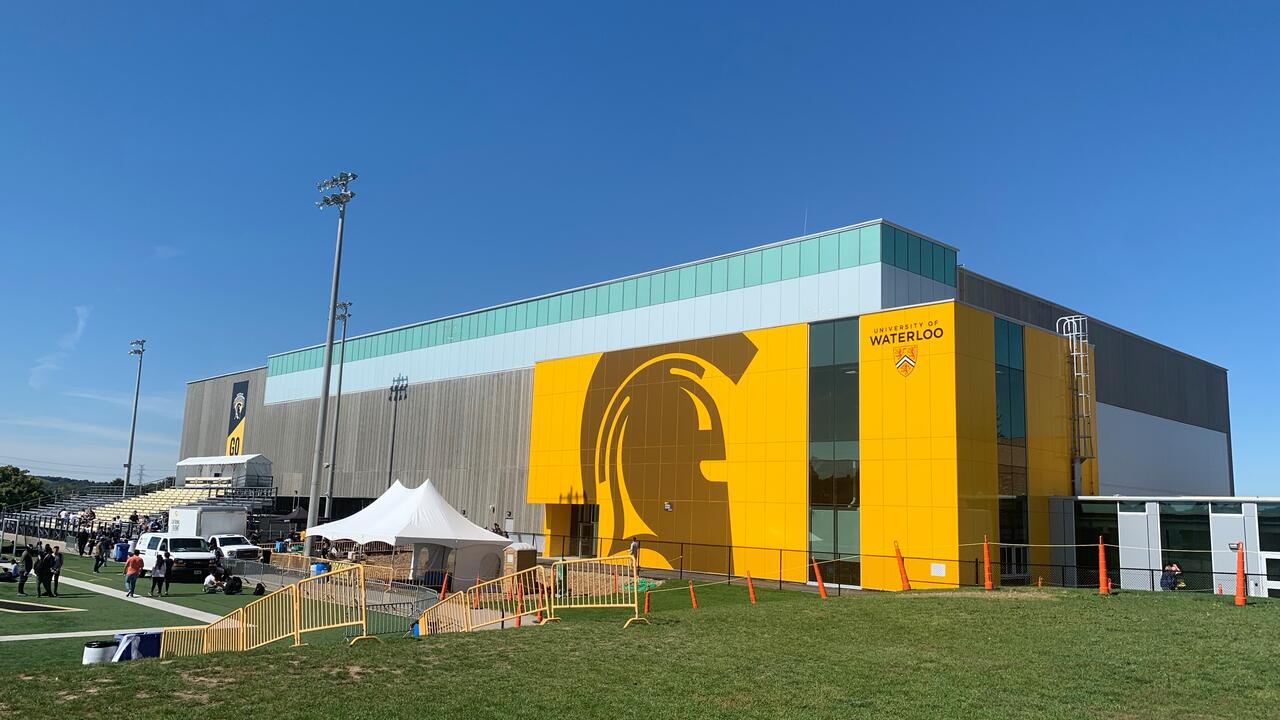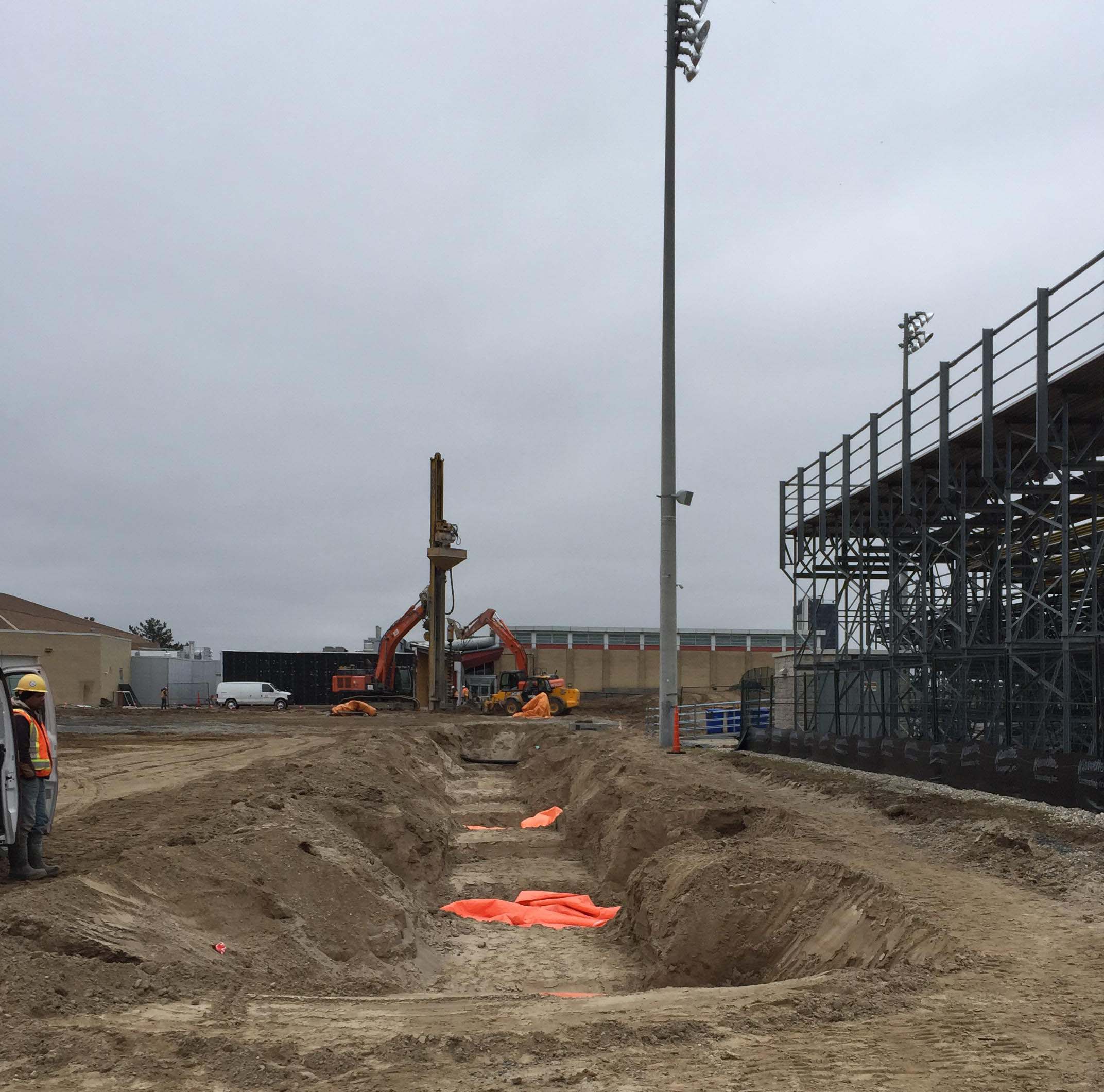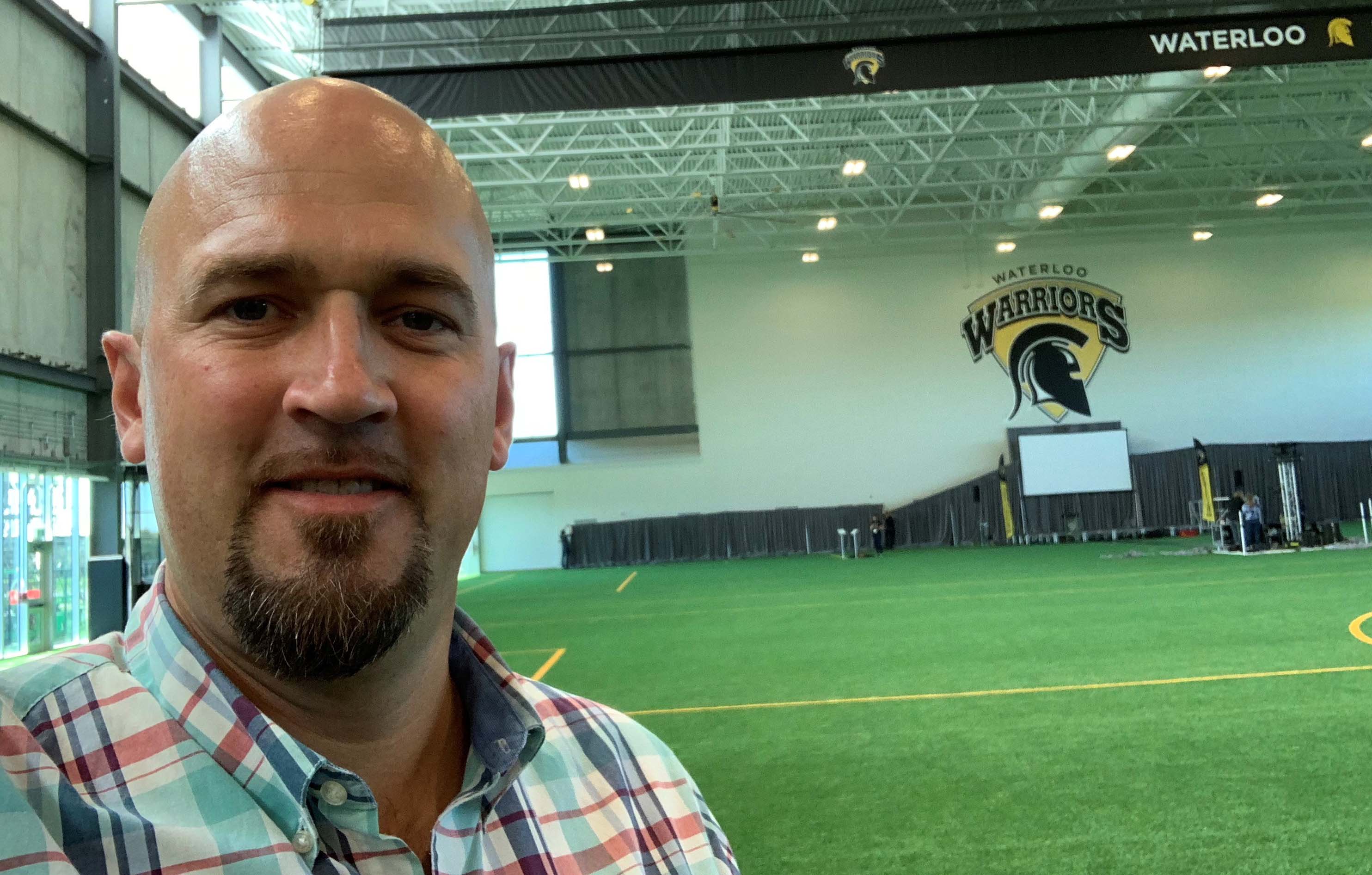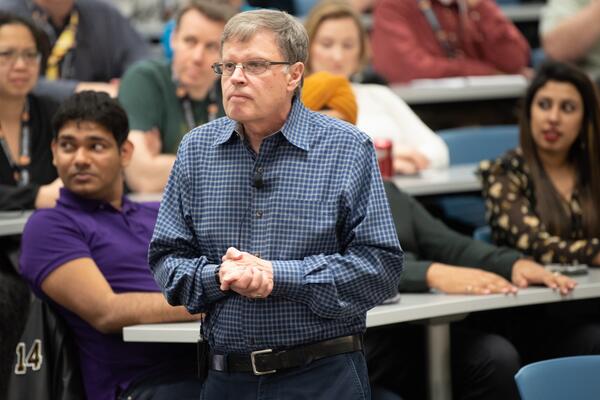
On solid footing
Grad's company created a ground improvement system for University building

Grad's company created a ground improvement system for University building
By Carol Truemner Faculty of EngineeringMark Tigchelaar attended the grand opening of Columbia Icefield Field House last September as a guest whose University of Waterloo education and student team experience helped ensure the building started off on a solid footing.
The engineering graduate’s company, GeoSolv Design/Build Inc., developed a low carbon footprint ground improvement system for the structure, a new 65,000 square-foot athletics and recreation space located north of the University’s Warrior Field.
The innovative foundation solution was engineered for the project after an analysis found there was poor fill soil under one part of the site.
GeoSolv worked with the building project’s design team to come up with an alternative to the traditional, more expensive and time-consuming  procedure of excavating the poor soils.
procedure of excavating the poor soils.
GeoSolv Design/Build Inc. developed a ground improvement system for the University's new athletics and recreation building.
The ground improvement method the company used, called the Geopier Impact® system, consisted of installing Rammed Aggregate Piers® into the ground a number of feet below the surface. The system built up lateral stress in the soil to allow it to carry much higher loads than it otherwise would have been able to in its natural state.
“We used what we call a matched-support solution – while some of the footings in the building footprint needed ground improvement, others didn’t,” says Tigchelaar. “We were able to be very cost-effective as a result.”
The ground improvement system adapted for the University’s field house is one of about a dozen used by the company since Tigchelaar founded GeoSolv in 2006, eight years after completing his University of Waterloo BASc degree in civil engineering with a geotechnical focus.
After graduation, he moved from company to company looking for the right opportunity to strike out on his own. That opportunity, which came while he was working for a company in Toronto, was to bring a new ground improvement technique developed in the U.S. to Ontario.
Since GeoSolv’s launch, the company has been the Ontario-based design/ build licensee and installer for the Geopier Foundation Company’s patented foundation systems, including the one used for the University’s field house.
GeoSolv landed its first job in early 2007 at Humber College in Toronto. Its second was a ground improvement system for the GO Transit Streetsville Bus Facility in Mississauga, beginning in August 2007.
“That was a very large job – about 100 times larger than our very first job at Humber,” he says. “It was a very steep learning curve, but really helped put us on the map.”
Today, GeoSolv has about 20 employees operating out of its Vaughan, Ontario location. While focused mainly on projects throughout the province, the company has worked as far west as Alberta.
 Tigchelaar says that among the many advantages of GeoSolv’s systems is that sub-excavation of the poor soils isn’t required, greatly reducing the time it takes to complete a project and its cost.
Tigchelaar says that among the many advantages of GeoSolv’s systems is that sub-excavation of the poor soils isn’t required, greatly reducing the time it takes to complete a project and its cost.
Mark Tigchelaar, founder and president of GeoSolv Design/Build Inc., inside the new Columbia Icefield Field House.
To determine what ground improvement technique GeoSolv uses for a particular job, Tigchelaar says his engineers look at many different aspects such as soil conditions, groundwater levels and the type of structure being built.
“We found the first couple of years we would use one system and then we would come across jobs where that one system wasn’t quite the right answer,” explains Tigchelaar, a member of the Professional Engineers Ontario and the Association of Professional Engineers and Geoscientists of Alberta. “That prompted us to find the right solution and add it to our arsenal.”
Problem-solving along with interacting with people are skills Tigchelaar says he gained as a Waterloo Engineering student both in the classroom and on co-op terms.
What he describes as one of his best learning experiences was being a member and the design manager of Arctic Fire Circle of Death, one of two toboggans created by the 1998 University of Waterloo Concrete Toboggan Team comprised of civil engineering students.
Built from a special mix of concrete and chopped fibrous glass, the unique circular toboggan with a pentagonal frame took first place in the Great Northern Concrete Toboggan Race (GNCTR), the largest and longest-running Canadian undergraduate engineering competition that alternates between universities in eastern and western Canada.
“It won the competition by a landslide,” Tigchelaar proudly recalls.
Although the team worked within the race’s design guidelines, the toboggan’s cutting-edge round shape made it impossible for the competition to successfully challenge at the four-day event hosted by the University of Calgary that year.
The rules were changed after the race so that toboggans similar in design to the winning Waterloo entry can no longer take part in the competition. Tigchelaar believes this was the first and perhaps only major rule change in the history of the competition.
Two years ago, alumni of the 1998 Arctic Fire Circle of Death and several other Waterloo concrete toboggan teams came back to campus to help with the GNCTR hosted by Waterloo Engineering and held at Chicopee Tube Park in Kitchener.
Tigchelaar and other team members dusted off their then 20-year-old toboggan and competed in separate fun races against other alumni teams.
They also took on and edged out the University of Alberta’s student team, the winners of the 2018 King of the Hill race, in a friendly downhill match that didn’t count towards the final GNCTR results.
 Waterloo's Arctic Fire Circle of Death concrete toboggan team in 1998 and, right, in 2008. Mark Tigchelaar is pictured at top left in the team's photo on the right.
Waterloo's Arctic Fire Circle of Death concrete toboggan team in 1998 and, right, in 2008. Mark Tigchelaar is pictured at top left in the team's photo on the right.
Tigchelaar expects his team’s toboggan will be pulled out of its custom-made shed in what he says is “an undisclosed secure location in Ontario” and put to the test again in future alumni recreational races.
He feels his team involvement as design manager, along with drumming up support through corporate sponsorships and selling Boggan Burgers to fellow students, helped round out his Waterloo engineering education.
“The competition team environment and my time in the classroom and on co-op gave me so many experiences that helped me launch and grow GeoSolv,” Tigchelaar says.

Read more
Fourth-year Global Business and Digital Arts student leverages artificial intelligence to fight food inflation, saving families up to $5,000 each year

Read more
Here are the people and events behind some of this year’s most compelling Waterloo stories

Read more
For more than four decades, Waterloo professor Larry Smith has helped build the University's reputation for innovation and entrepreneurial excellence
Read
Engineering stories
Visit
Waterloo Engineering home
Contact
Waterloo Engineering
The University of Waterloo acknowledges that much of our work takes place on the traditional territory of the Neutral, Anishinaabeg, and Haudenosaunee peoples. Our main campus is situated on the Haldimand Tract, the land granted to the Six Nations that includes six miles on each side of the Grand River. Our active work toward reconciliation takes place across our campuses through research, learning, teaching, and community building, and is co-ordinated within the Office of Indigenous Relations.